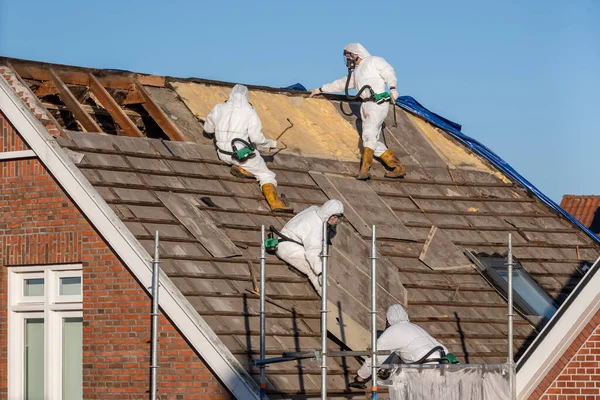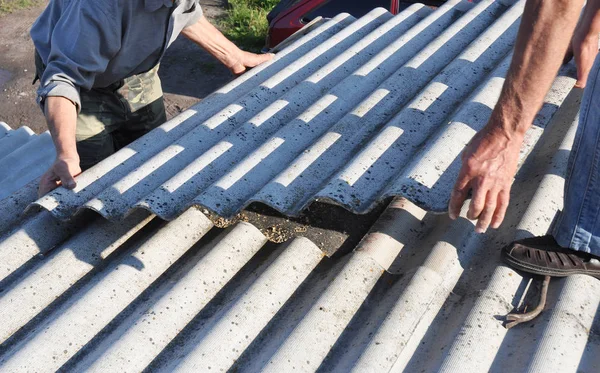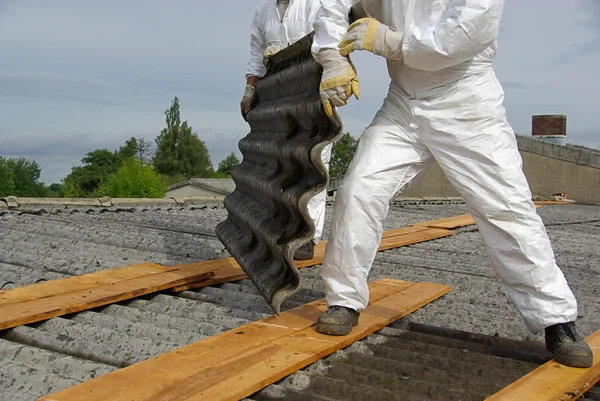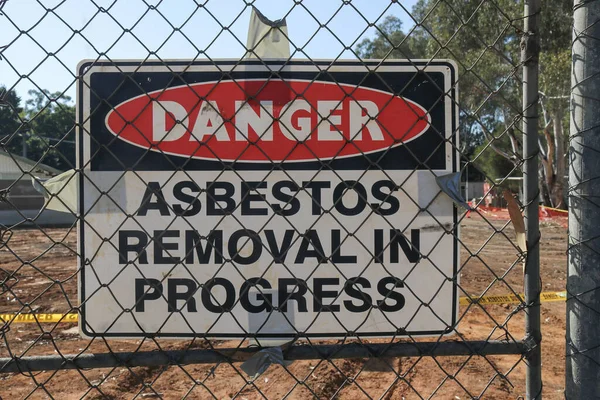Asbestos was commonly used for centuries – even the ancient Greeks and Romans used drywall materials due to their practical features, such as heat, electricity, and fire resistance.
During the 20th century, the use of asbestos reached its peak in North America, particularly in the 1940s and 1950s. Despite its widespread use, the health risks associated with asbestos were only discovered later.
But these days, everyone knows that asbestos is a harmful mineral. We no longer use asbestos-containing drywall or gypsum in construction because we understand its health and environmental risks.
However, the question arises: why was asbestos-based drywall massively used during the last century, and why was it a threat to your health?
In this article, we will explore the history of asbestos usage and delve into the risk of asbestos in your drywall.

Key Takeaway
- Asbestos was widely adopted in construction in the 1950s before its health hazards were recognized, leading to widespread dangerous exposure.
- Diseases from asbestos exposure often don’t appear for many years, delaying recognition of the health impacts.
- Asbestos is very difficult and expensive to safely remove from buildings today, and it still lingers in many older structures.
- Massive litigation related to asbestos exposure has cost companies over $100 billion so far. The impacts of past use of this hazardous material continue today.
Asbestos Use Became Widespread in the 1950s, Building Boom
During the 1950s, the construction industry experienced a significant growth. Houses became more affordable for middle-class families, and many wanted to move from urban areas to the suburbs to live with their families, particularly after World War II.
During its heyday, asbestos-containing drywall or joint compound was widely favored for its perceived benefits in construction projects.
Asbestos, considered a “miracle material,” was widely used during this period due to its unique properties, such as fire resistance and durability.
As a result, it became a popular choice for insulation and was added to many construction materials, such as drywall (gypsum wallboard), ceilings, floor tiles, and cement. It was even used as a joint compound to improve its texture while working.
Despite its practicality and affordability, the health risks associated with asbestos exposure were unknown. Asbestos was considered a harmless material, and its use was widespread.
Despite its evident popularity in this era, it’s crucial to be aware that asbestos-containing joint compounds may lurk in the walls of older homes, posing potential health risks.
Here’s a tip for modern-day asbestos use:
If there is asbestos in your walls, it is essential to address the issue promptly to mitigate any dangers.
Since this hazardous substance was commonly used in drywall and various construction materials, this emphasizes the importance of taking necessary precautions to ensure a safe living environment.
The point is, if your home may contain asbestos, don’t sleep on it.
Popularity Led Manufacturers Like US Gypsum to Put Asbestos in Many Products

In the 1950s, leading manufacturers put chrysotile asbestos in many products.
United States Gypsum Company produced Sheetrock, an asbestos drywall brand. Sheetrock mud was used as a wall-joint compound. Other companies also used asbestos in drywall panels and sheets for interior walls and ceilings.
Some of the joint compounds made by Kaiser Gypsum Company Inc. may have contained asbestos.
Fibers of this mineral were used to create a “popcorn ceiling,” a popular design choice in many homes during the mid-20th century.
Additionally, it was employed for loose-fill, batt, or blanket-type insulation – providing homes with warmth and energy efficiency. However, it’s important to note that disturbing asbestos materials can release asbestos fibers into the air.
These fibers are too small to be seen by the naked eye, making it imperative to handle asbestos-containing materials with caution to prevent exposure.
It was frequently added to adhesives and joint compounds for flooring or tile installation. Ideally, it aimed to enhance bonding strength and fire resistance.
Between the 1930s and 1980s, the asbestos-containing joint compound was a common choice for sealing seams between drywall panels, ensuring a smooth finish.
This pre-mixed paste, containing asbestos, may have been applied liberally, especially in homes constructed before the 1980s, potentially contributing to the presence of asbestos in the joint compound.
Asbestos cement boards, composed of a mixture of cement and asbestos fibers, were used for siding, roofing, and flooring due to their strength and durability.
Most of the buildings built after the 1930s probably contained asbestos since the interior walls of old buildings were partially constructed of drywall products.
Why 1950s Asbestos Exposure Was So Dangerous
Asbestos was heavily used in construction during the 1950s, and its prevalence persisted in millions of homes, particularly those constructed before the 1980s, when regulations on asbestos use became more stringent.
After several decades of consistent use, drywall became prevalent in millions of homes. In many residential and commercial buildings, it replaced traditional plaster and lath construction methods.
However, during that time, only some of the health risks were associated with it and understood.
Many individuals who worked in the construction industry may have been exposed to this harmful substance without realizing the potential consequences. Due to a lack of awareness, people did not take any protective measures.
Asbestos Dust is Highly Toxic

In the 1960s and 1970s, scientific studies discovered that asbestos may cause severe health problems like mesothelioma, lung cancer, and asbestosis. As a result, many governments and health organizations started acting to regulate or ban materials containing asbestos.
Dr. Irving J. Selikoff was a renowned physician from New York who specialized in asbestos-related diseases from the 1960s to the 1990s. He famously stated: “Any level of exposure to asbestos can increase the risk of disease, and even a single exposure can be harmful.”
Dr. Selikoff’s pioneering research led to various epidemiological studies among workers in asbestos mining, manufacturing, and insulation installation.
His study provided crucial evidence that linked asbestos exposure to diseases such as asbestosis, lung cancer, and mesothelioma. Despite being accused of fraud and causing panic, he persevered with his research, which revealed alarming findings.
Asbestos is very harmful because one can’t see its microscopic fibers – they are too small to be visible to the naked eye.
If inhaled, even in small amounts, these fibers can become lodged in the lungs and pose serious health risks. Therefore, there is no safe level.
Asbestosis is a chronic lung disease that can develop due to exposure to its fibers. This condition causes scarring of the lung tissue and can result in shortness of breath.
Effects Often Don’t Appear for Decades
Asbestos exposure is a major concern because related diseases can take decades to manifest. Despite widespread use in the 1950s, the associated health problems were fully realized in the 1970s, 80s, and beyond.
The period between exposure and diagnosis is called the latent period, which can last 10 to 50 years. A
s a result, it may be difficult to connect the health issues of construction workers exposed to asbestos fibers with their past occupational exposure since symptoms may not appear until several decades later.
Difficult and Costly Removal
Asbestos is a hazardous mineral that can cause serious lung problems if inhaled. It is often present in older buildings, and removing it is difficult and expensive. Strict protocols and specialized equipment are required to remove it safely.
It’s essential to understand that getting rid of asbestos is regulated by government rules. Doing it on your own is not recommended; it’s crucial to hire a certified asbestos removal professional, considering the associated costs.
If asbestos-containing materials are disturbed during remodeling or demolition, asbestos fibers can be released into the air, which can cause serious health problems.
Therefore, specialized equipment and training are necessary for drywall construction removal. HEPA filters and specialized clothing are also required to ensure safety.
Disposing of asbestos-containing products is expensive as they must be disposed of in approved landfills that can handle hazardous materials. Proper packaging, transportation, and disposal methods are needed to ensure environmental safety.
The removal process is time-consuming as people must be careful to minimize the release of fibers into the air. Failure to take proper precautions can cause damage to the surrounding properties.
Impact on Construction Workers Was Severe

People used to work with asbestos without knowing its harmful effects on their health. Drywall hangers, tapers, and plasterers who worked with asbestos were at great risk of inhaling the dangerous substance.
These workers didn’t use any protective gear to protect themselves from airborne asbestos dust, especially when removing old dry walls that released toxic asbestos fibers.
The exposure happened through inhalation of asbestos fibers due to cutting, drilling, sanding, and handling asbestos-containing materials.
Construction workers in the past weren’t given special equipment or training, which led to many of them developing asbestos-related diseases.
However, they couldn’t afford proper treatment, and they faced difficulties in terms of medical expenses, lost wages, and physical disabilities.
Consequently, many took legal action against construction companies and manufacturers to get compensation for their health conditions.
Legacy Hazards Linger in Homes Today
Old buildings and homes built in the U.S. before the 1980s may still contain asbestos. Therefore, you should refrain from renovating your old house on your own.
Any attempt to break or remove asbestos-based drywalls by yourself could lead to you and your family inhaling it.
Before starting any renovation or demolition work, you should test for asbestos. As previously stated, only trained professionals wearing protective gear should handle this substance.
You can’t see asbestos fibers, and even the slightest exposure can cause health problems, so avoid DIY projects and call a professional.
Why Was It Considered a Disaster and The Worst Building Mistake
Asbestos is now widely recognized as the worst building mistake in history due to its negative impact on human health.
Asbestos exposure has been linked to various diseases, and unfortunately, people continue to live in buildings that contain this material. This means that the health risks associated with asbestos will likely continue to be a problem in the future.
Another challenge with asbestos is that remodeling or renovating old houses containing the substance can be difficult and costly. Handling the material safely requires a professional team with specialized equipment and training. Safe disposal of asbestos is also complicated and expensive.
It’s important to raise public awareness about asbestos’s dangers. Numerous lawsuits have been filed by construction workers and individuals who have been exposed to asbestos, causing mistrust toward construction companies, manufacturers, and the government.
Disposing of this material can also pose environmental risks, as fibers may contaminate wildlife and ecosystems.
1950s Asbestos and Litigation
After the harmful effects of asbestos on human health were established, many companies in America faced legal action.
Over a million claims for asbestos-related personal injury compensation have been filed in the US since the 1970s, and thousands of new claims are being filed every year. Many of these claims are due to occupational exposure, such as drywall application.
Many companies involved in asbestos have been forced into bankruptcy due to the ongoing effort and cost of managing litigation claims over several decades. Asbestos manufacturers like US Gypsum and National Gypsum have faced extensive lawsuits.
According to a 2020 RAND report, US companies and insurers face over $100 billion in asbestos liability costs. Costs are related to litigation and compensation payments.
Asbestos manufacturers have created trust funds for around $37 billion to compensate plaintiffs with current and future claims. Several of these funds are associated with companies from the 1950s.
These figures leave no room for doubt about the astronomical expenses incurred due to asbestos-related lawsuits, affecting companies, insurers, trusts, and the entire economy. These costs are not exclusive to 1950s home building litigation.
The era’s negligent approach to protecting construction workers and consumers has led to many ongoing lawsuits. Although it may be difficult to determine the exact costs associated with 1950s home asbestos cases, the broader impact of the asbestos litigation landscape since the 1970s has been substantial, amounting to at least tens of billions of dollars.
